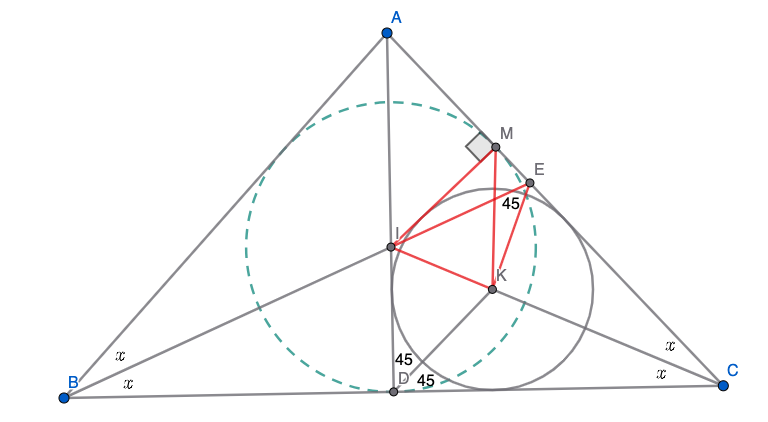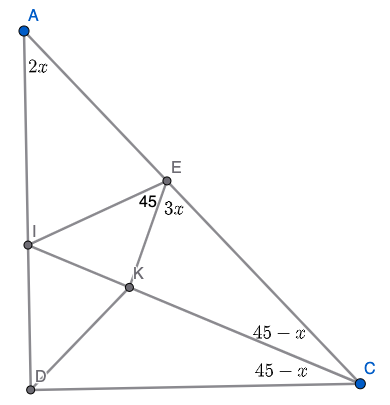2009 IMO Problems/Problem 4
Contents
[hide]Problem
Let ![]() be a triangle with
be a triangle with ![]() . The angle bisectors of
. The angle bisectors of ![]() and
and ![]() meet the sides
meet the sides ![]() and
and ![]() at
at ![]() and
and ![]() , respectively. Let
, respectively. Let ![]() be the incenter of triangle
be the incenter of triangle ![]() . Suppose that
. Suppose that ![]() . Find all possible values of
. Find all possible values of ![]() .
.
Authors: Jan Vonk and Peter Vandendriessche, Belgium, and Hojoo Lee, South Korea
Solution 1
Extend ![]() to meet
to meet ![]() at
at ![]() . Then, we can see that
. Then, we can see that ![]() is the incenter of
is the incenter of ![]() , so
, so ![]() , where
, where ![]() is the intersection of the incircle with
is the intersection of the incircle with ![]() .
.
Since ![]() bisects
bisects ![]() , we have
, we have ![]() , so
, so ![]() .
.
From here, there are two possibilities: either ![]() and
and ![]() coincide or they don't. If
coincide or they don't. If ![]() and
and ![]() coincide, then
coincide, then ![]() is the median and the altitude from
is the median and the altitude from ![]() , so
, so ![]() , and therefore
, and therefore ![]() is equilateral, so
is equilateral, so ![]() .
.
Otherwise, we have ![]() is cyclic, and
is cyclic, and ![]() , so
, so ![]() is the diameter of
is the diameter of ![]() , so
, so ![]() and
and ![]() . Also,
. Also, ![]() , so
, so ![]() , so
, so ![]() , which is the second possible value of
, which is the second possible value of ![]() .
.
Solution 2
We will be using the trig bash solution given in EGMO.
Let ![]() be the incenter, and set
be the incenter, and set ![]() with
with ![]() . From
. From ![]() , it is easy to compute
, it is easy to compute ![]()
Then, by LoS, we have ![\[\dfrac{IK}{KC} = \dfrac{\sin 45^\circ \cdot \frac{EK}{\sin(90^\circ - 2x)}}{\sin(3x) \cdot \frac{EK}{\sin(45^\circ-x)}} = \frac{\sin 45^\circ \sin(45^\circ - x)}{\sin(3x) \sin(90^\circ-2x)}.\]](http://latex.artofproblemsolving.com/a/2/1/a21b665b9edda9f1cc2e5061499315fd09c8e062.png)
Also, by the angle bisector theorem on ![]() , we get
, we get ![]()
Equating the above two equations and cancelling ![]() , we get
, we get ![]()
Applying product to sum, we get ![]() or simply
or simply ![]() . Then, applying difference to product, we get
. Then, applying difference to product, we get ![]()
Then, we get two cases: ![]() or
or ![]() . Note that these hold iff the expressions inside the sines are multiples of
. Note that these hold iff the expressions inside the sines are multiples of ![]() . Using the bound
. Using the bound ![]() , we can easily get that the only possible values are
, we can easily get that the only possible values are ![]() and
and ![]() , so
, so ![]() .
.
See Also
| 2009 IMO (Problems) • Resources | ||
| Preceded by Problem 3 |
1 • 2 • 3 • 4 • 5 • 6 | Followed by Problem 5 |
| All IMO Problems and Solutions | ||











